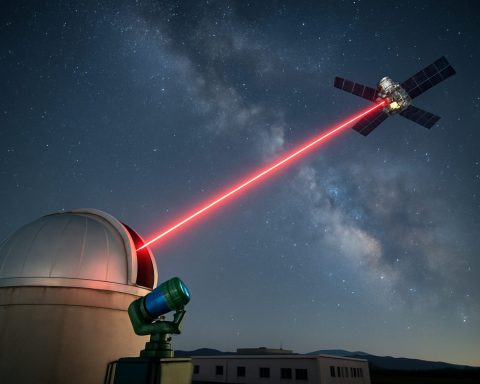- The James Webb Space Telescope (JWST) provides the first clear evidence of Neptune’s auroras, revealing the planet’s enigmatic wonders.
- Neptune’s auroras, unlike Earth’s, occur at mid-latitudes due to the planet’s uniquely tilted magnetic field.
- High-energy particles from the Sun, captured in Neptune’s magnetic field, create vibrant cyan emissions in the upper atmosphere, indicating the presence of trihydrogen cation (H₃⁺).
- JWST’s observations reveal that Neptune’s upper atmosphere has mysteriously cooled by several hundred degrees since 1989, sparking scientific intrigue.
- Future studies of Neptune’s auroras over a complete solar cycle may provide insights into the planet’s magnetic field and its interaction with solar winds.
- This research underscores the potential of advanced technology to unravel cosmic mysteries and inspire further space exploration.
The vastness of space, a domain of mystery and exploration, has revealed yet another of its enigmatic wonders: the auroras of Neptune. Through the piercing eye of the James Webb Space Telescope (JWST), scientists have captured the first clear evidence of these radiant displays, shedding light on the unseen curiosities of our solar system’s distant giant.
Imagine a symphony of colors coursing through the skies of a world far removed from ours—this is the celestial dance observed on Neptune, glowing in infrared hues thanks to JWST’s unmatched capabilities. These images provide not only a breathtaking view but also a crucial understanding of Neptune’s magnetic prowess. Unlike the auroras that grace Earth’s polar regions, Neptune’s are painted across its mid-latitudes—a phenomenon birthed from its quirky magnetic field, distinctly tilted at 47 degrees to its axis.
This magnetic artistry forms when high-energy particles from the Sun are ensnared in Neptune’s magnetic net and collide with its upper atmosphere. The result is an astral ballet of cyan patches captured in vivid detail—reminiscent of dreamscapes imagined in science fiction. These vibrant cyan emissions are more than just picturesque; they signify the presence of the elusive trihydrogen cation (H₃⁺), detected clearly for the first time, lifting the veil on Neptune’s ionosphere.
Venturing beyond the colorful spectacle, JWST’s observations unlocked Neptune’s climatic secrets. Recent temperature measurements of the upper atmosphere pointed to an astonishing find: since the Voyager 2 flyby in 1989, Neptune’s upper atmosphere has mysteriously cooled by several hundred degrees. This unexpected chill intrigues scientists, hinting at dynamic interactions between the solar winds and Neptune’s magnetic barrier.
As astronomers continue to peer into the vast Neptune night, the prospect of studying these auroras over a full solar cycle gleams with promise. Understanding how Neptune stands poised against the Sun’s relentless particle stream invites further inquiry into the planet’s erratic magnetic field, offering whispers of cosmic origin stories yet to be told.
The takeaway from this dazzling breakthrough is profound: armed with the power of cutting-edge technology, humanity steps ever closer to unraveling the universe’s intricate tapestry. The James Webb Space Telescope not only illuminates Neptune’s mysteries but also inspires a renewed quest for discovery in the uncharted territories of space’s final frontier.
Neptune’s Mesmerizing Auroras: A New Chapter in Space Exploration
Understanding Neptune’s Auroras: Beyond the Light Show
Neptune’s auroras offer more than just a dazzling display; they open a window into the deeper workings of our solar system’s dynamics. Here are additional facts and insights that enhance our understanding of this celestial phenomenon:
How Auroras Form on Neptune
On Neptune, auroras occur when solar wind particles become trapped and guided by the planet’s magnetic field, colliding with its upper atmosphere. However, unlike Earth, Neptune’s magnetic field is offset and tilted significantly. This results in auroral displays extending over its mid-latitudes rather than being confined to the poles. This unique magnetic orientation also exposes Neptune to solar winds differently, contributing to distinct atmospheric interactions.
The Role of Trihydrogen Cation (H₃⁺)
– Detection of H₃⁺: The presence of the trihydrogen cation is significant as it offers clues about the ionospheric conditions and the chemistry of Neptune’s atmosphere. H₃⁺ may play a critical role in cooling the ionosphere, which helps explain the observed temperature drop over the decades.
Understanding Neptune’s Cooling Atmosphere
Neptune’s unexpected atmospheric cooling adds a layer of complexity to our understanding of atmospheric physics on giant planets. The cooling could be due to several factors, including changes in solar activity, atmospheric chemistry, or even broader climatic cycles specific to Neptune.
Real-World Use Cases for JWST’s Discoveries
JWST’s findings go beyond academic interest:
– Modeling Exoplanets: Understanding Neptune’s atmospheric behavior aids in modeling the atmospheres of exoplanets similar in size or composition to Neptune, contributing to the search for potentially habitable planets.
– Comparative Planetology: Studying Neptune’s auroras allows scientists to compare magnetic field interactions across different planetary environments, enhancing our understanding of planetary magnetospheres.
Market Forecasts & Industry Trends
The discovery accentuates the growing role of technologically advanced space telescopes like the JWST in space research, impacting:
– Investment in Space Exploration: Enhanced interest in studying gas giants could lead to increased funding and technological development in space exploration missions.
– Commercial Space Ventures: The insights gained from such discoveries could influence future commercial initiatives aimed at harnessing and exploring the unique environments of the outer planets.
Pros & Cons of the JWST’s Discoveries
Pros:
– Expanded Knowledge: Advances understanding of magnetic fields and atmospheric chemistry of distant planets.
– Technological Achievement: Demonstrates the capabilities of modern space telescopes in capturing high-quality data on distant celestial phenomena.
Cons:
– Limitations of Reach: Despite its capabilities, the JWST cannot capture temporal changes as effectively as instruments closer to the target.
– Dependence on Existing Data: Interpretations are heavily reliant on previous missions, like Voyager 2, for historical comparison.
Actionable Recommendations
For space enthusiasts and professionals wanting to delve deeper:
1. Stay Informed: Regularly follow updates from space agencies like NASA for new discoveries regarding Neptune and other celestial bodies.
2. Educational Engagement: Participate in webinars or online courses on astrobiology and planetary science to understand the implications of such discoveries.
3. Support Research Initiatives: Consider contributing to or supporting organizations that fund space exploration and scientific research, accelerating humanity’s reach into the cosmos.
For more information on cutting-edge space research, visit NASA.
The breathtaking and mysterious auroras of Neptune, as revealed by the JWST, not only captivate the imagination but also pave the way for future explorations, providing a clearer understanding of the universe’s vast complexities.












